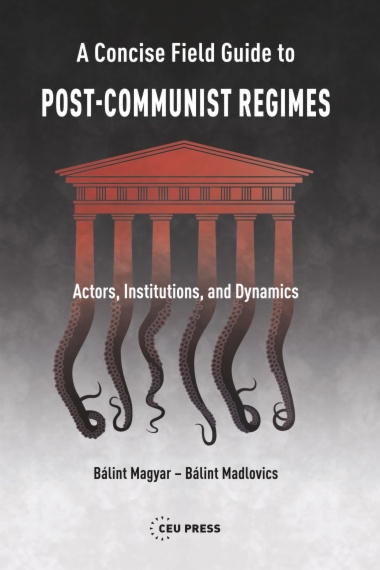While the literature of hybrid regimes has given up the presumption that post-communist countries must democratize, its language and concepts still mostly relate to Western democracies. Magyar and Madlovics strongly argue for a vocabulary and grammar tailored to the specifics of the region. In 120 theses they unfold a conceptual framework with (1) a typology of post-communist regimes and (2) a detailed presentation of ideal-type actors and the political, economic, and social phenomena in these regimes. The book is a more digestible companion to the 800-page The Anatomy of Post-Communist Regimes (CEU Press, 2020), which was a detailed theoretical study with plenty of empirical illustrations.
Each of the 120 theses contains a statement and its concise discussion supported by illustrative tables, figures, and QR-codes that connect the interested reader to the more detailed analysis in the Anatomy. In a condensed variety, this book has kept the holistic approach of the Anatomy and treats the spheres of political, market, and communal action as parts of a single, coherent whole. The endeavor to synthesize a vast range of ideas does not, however, result in a too complicated text. On the contrary, freed from the implicit presumptions of democracy theory, the new terminology yields a readily usable toolkit of unambiguous means of expression to speak about post-communism.
- Cover
- Front matter
- Half title
- Title page
- Copyright page
- Table of Contents
- FOREWORD. A new paradigm for understanding post-communistregimes
- User’s guide to the book
- I. The Conceptual Framework: 120 Propositions
- Trapped in the Language of Liberal Democracy
- Dissolving Axiom #1: Stubborn Structures and the Region’s Development
- Dissolving Axiom #2: Formality and Informality
- Dissolving Axiom #3: From Constitutional State to the Mafia State
- A Sui Generis Phenomenon: the Adopted Political Family
- The Formal Institutional Setting: Changing Patterns of Legitimacy
- Legislation and the Legal System: From the Rule of Law to the Law of Rule
- Defensive Mechanisms: Stability and Erosion of Democracies and Autocracies
- Relational Economics: Corruption, Predation, and the Redistribution of Markets
- Market-Exploiting Dictatorship: Coexistence of the Three Economic Mechanisms in China
- Clientage Society and the Social Stability of Patronal Autocracy
- Populism: an Ideological Instrument for the Political Program of Morally Unconstrained Collective Egoism
- Beyond Regime Specificities: Country-, Policy-, and Era-Specific Features
- Post-Communist Regime Trajectories: A Triangular Framework
- II.Trajectories of Twelve Post-Communist Regimes
- Estonia: Regime Change to Liberal Democracy
- Romania: Regime Change to Patronal Democracy
- Kazakhstan: Regime Change to Patronal Autocracy
- China: Model Change to Market-Exploiting Dictatorship
- Czech Republic: Backsliding Toward Patronal Democracy
- Poland: Backsliding Toward Conservative Autocracy
- Hungary: Backsliding to Patronal Autocracy from Liberal Democracy
- Russia: Backsliding to Patronal Autocracy from Oligarchic Anarchy
- Ukraine: Regime Cycles with Color Revolutions
- North Macedonia: Regime Cycle with Intra-Elite Conflict
- Moldova: Regime Cycles with Foreign Interference
- Georgia: An Attempt to Break the Regime Cycle
- Notes
- About the Authors
- Back cover

